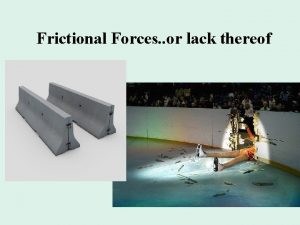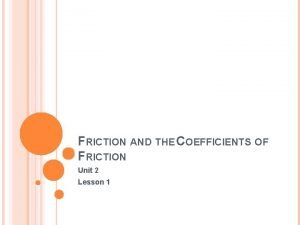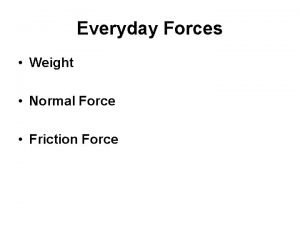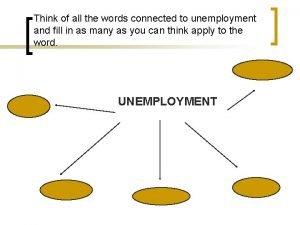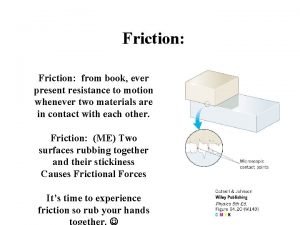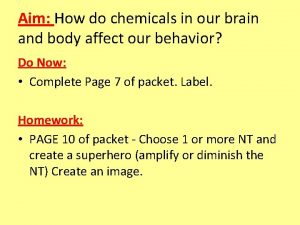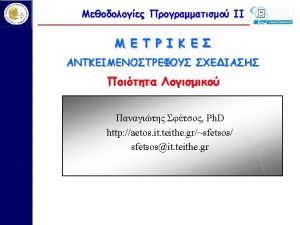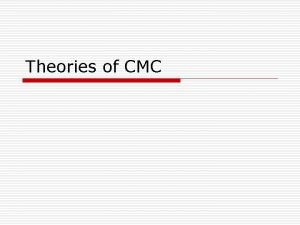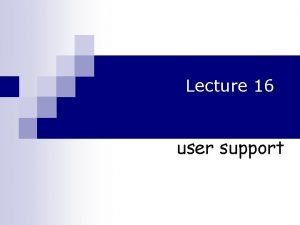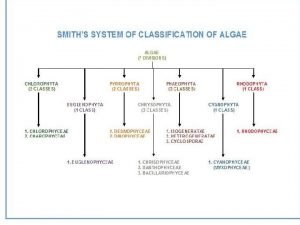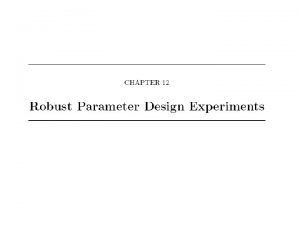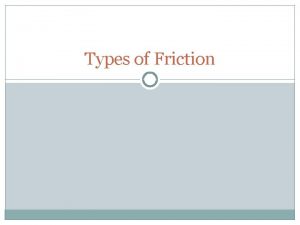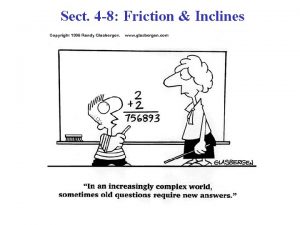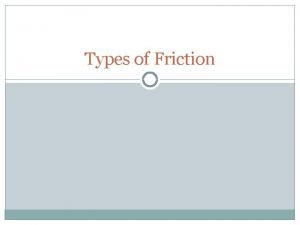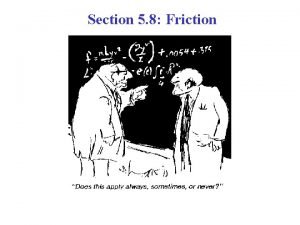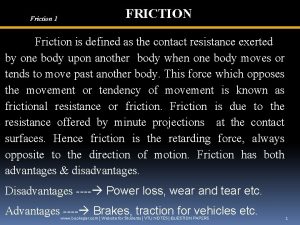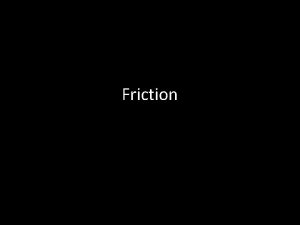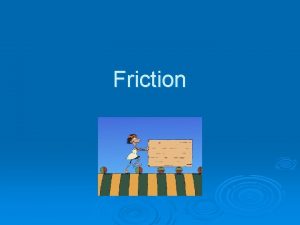Frictional Forces or lack thereof Friction Definition the











































- Slides: 43

Frictional Forces. . or lack thereof

Friction Definition: the force that opposes the motion of one surface past another Dependent upon: 1) type of material 2) how tightly pressed they are together (more weight =more friction) It’s time to experience friction, so rub your hands together.

Why would a snowboarder wax the board? What conditions would change the frictional force as they move downhill?

Characteristics of friction 1) ALWAYS opposes motion a) it will slow it b) or prevent it from moving 2) Creates heat 3) Symbol is lowercase ‘f’…Ff

2 types of friction Static 1) prevents motion from starting. 2) occurs before motion Which is bigger…static or kinetic? Kinetic friction 1) slows objects down. 2) occurs during motion It is easier to keep an object moving than start it from rest


New Symbol • μ – Greek letter “Mu” • Coefficient of friction. – μs – coefficient of static friction – μk – coefficient of kinetic friction – depends on materials used and their surface conditions • Coefficient of friction: Decimal between 0. 0 and 1. 0, unitless. • Formula for solving friction: F f = μ FN

Sand is often placed on an icy road because the sand: Decreases the coefficient of friction between the tires of a car and the road Increases the coefficient of friction between the tires of a car and the road Decrease the gravitational force on a car Increases the normal force of a car on the road

An empty cart is being rolled across a warehouse floor. If the cart was filled, the force of kinetic friction between the cart and the floor would Decrease Increase Remain the same

A 24 kg crate initially at rest on a horizontal floor requires a 75 N horizontal force to set it in motion. Find the coefficient of static friction between the crate and floor.

Once the crate is in motion, a horizontal force of 53 N keeps it moving with constant velocity. Find the coefficient of kinetic friction between the crate and floor.

A 55 kg baseball player slides into third base with an initial speed of 4. 6 m/s. If the coefficient of kinetic friction between the player and the ground is 0. 46, what is the player’s acceleration? How far did he slide? 1) Always draw your FBD 2) Fnet= ma= Ff 3) Ff=µFN =0. 46(539 N) = -248 N 4) F=ma a= F/m =-248 N/55 kg = -4. 5 m/s²

Where does this apply? To car tires in accidents. By measuring the length of skid marks, police can calculate the speed a car was going before an accident.

Static and Kinetic Frictional Force Formula 1) FN= mg = weight 2) fk = k FN Known Variables Fk = 0. 0500 vo = 4. 00 m/s vf = 0. 00 m/s 3) ΣF= max = k FN Unknown Variables ax = 4) max = k mg x = 5) (/m=>) ax= k g 6) ax =. 05 (9. 80 m/s 2) 7)vf 2=vo 2+2 axx. Find x

Static and Kinetic Frictional Force Formula 1) FN= mg = weight 2) ΣF= fk , fk = k FN 3) ΣF= max = k FN Known Variables Unknown Variables k = 0. 0500 ax = 0. 49 m/s 2 4) max = k mg vo = 4. 00 m/s x =16. 3 m 5) (/m=>) ax= k g vf = 0. 00 m/s 6) ax =. 05 (9. 80 m/s 2) 7)vf 2=vo 2+2 axx. Find x

Static and Kinetic Frictional Force Did we need to know the mass of the sleder? No. Why? It cancels out in the ax equation. Real Life Ap: This applies to car tires in accidents. By measuring the length of skid marks, they can calculate the speed a car was going before an accident. k of a tire is the same for all cars since it does not depend on car mass or surface area of the tires. Formula 1) FN= mg = weight 2) ΣF= fk , fk = k FN 3) ΣF= max = k FN 4) max = k mg 5) (/m=>) ax= k g 6) ax =. 05 (9. 80 m/s 2) 7)vf 2=vo 2+2 axx. Find x

Static and Kinetic Frictional Forces Static Frictional Force: Reaction force to anything trying to start motion. • Equal and opposite to applied force. • DOES NOT EXCEED THE APPLIED FORCE, but is equal to it.

Static and Kinetic Frictional Forces Static Frictional Force: Reaction force to anything trying to start motion. Equal and opposite to applied force, until reaches maximum value and motion starts. friction “breaks” when F is great enough and motion begins.

Static and Kinetic Frictional Forces Static Frictional Force Breaks at a certain value: fs = s F N fs = force of static friction s = coefficient of static friction FN = Normal force

Static and Kinetic Frictional Forces Static Frictional Force Breaks at a certain value: fs = s F N fs = force of static friction s = coefficient of static friction FN = Normal force s is a given value. It depends on the object and the surface.

Static and Kinetic Frictional Forces Static Frictional Force: fs = force of static friction s = coefficient of static friction FN = Normal force (usually weight) Normal force is usually just the weight of the object. FN = Mass* 9. 80 m/s 2 IMPORTANT!!!!! If the surface is not horizontal use trig. Multiply by cos of the angle of incline.

Notes on friction Almost always: μ s > μk It is easier to keep an object moving than it is to start from rest. Think about pushing a car. Both are almost always less than 1. If it was greater than one, it would be easier to pick the object up and carry it than it would be to push it across the flat surface (something like velcro)

Problem Box: How much force is needed to “budge” this box? If we keep pushing that hard, what will the acceleration be?

Box: Problem fs = s FN =. 4 (10 kg) ( 9. 80 m/s 2) fs = 39 N (Breaking Force)

Problem Box: fk = k FN =. 2 (10 kg) ( 9. 80 m/s 2) fk = 19. 5 N (Kinetic Force) Net Force = Pushing Force – Kinetic Friction Force Net Force = 39 N – 19. 5 N = 19. 5 N a = F / m = 19. 5 N / 10 kg = 1. 95 m/s 2 = 2 m/s 2

The Tension Force

The Tension Force Tension is the force balanced by a rope, cable or wire. A “simple pulley” changes direction without affecting tension. Tension is the same at every point in a single rope.

Equilibrium Applications of Newton’s Laws of Motion An object is in equilibrium when it has zero acceleration “equilibrium” refers to a lack of change, but in the sense that the velocity of an object isn’t changing, i. e, there is no acceleration. Equilibrium: Constant Speed and Direction. Fx = 0 and Fy = 0, ax = 0 m/s 2 and ay = 0 m/s 2 F = 0 and F = 0 x y

Reasoning Strategy If F = 0, then Fx = 0 and Fy = 0. • Draw a free-body diagram the object. Be sure to include only the forces that act on the object; do not include forces that the object exerts on its environment.

Example A jet plane is flying with a constant speed along a straight line at an angle of 30. 0 o above the horizontal. The plane has a weight W whose magnitude is W=86, 500 N and its engine provide a forward thrust T of magnitude T=103, 000 N. In addition, the lift force L (directed perpendicular to the wings) and the force R of air resistance (directed opposite to the motion) act on the plane. Find L and R.

List our Forces: Weight – 86, 500 @ 270 Thrust - 103, 000 @ 30 Lift - ? ? ? @ 120 Drag - ? ? ? @ 210 (drag is a friction)

List our Forces: Weight – 86, 500 @ 270 Thrust - 103, 000 @ 30 Lift - ? ? ? @ 120 Drag - ? ? ? @ 210 (drag is a friction) This looks really complicated.

Shortcut: Since 3 of our forces are Perpendicular, lets change The axes. . .

Now: Weight – 86, 500 @ 240 Thrust - 103, 000 @ 0 Lift - ? ? ? @ 90 Drag - ? ? ? @ 180 (drag is a friction) 3 nice angles are better than 1.

x component W: 86, 500 cos 240 L: 0 (L cos 90) T: +103, 000 N R: -R (R cos 180) y component W: 86, 500 sin 240 L: +L T: 0 R: 0 Fx = W cos 240. 0 o + T -R = 0 Fy = -Wcos 30. 0 o + L= 0 R=59, 800 N and L = 74, 900 N

Nonequilibriuium Applications of Newton’s Laws of Motion Non-equilibrium conditions occur when the object is accelerating and the forces acting on it are not balanced so the net force is not zero. Non-equilibrium: Fx = max and Fy = may

Example A supertanker of mass m = 1. 50 X 108 kg is being towed by two tugboats. The tensions in the towing cables apply the forces T 1 and T 2 at equal angles of 30. 0 o with respect to the tanker’s axis. In addition, the tanker’s engines produce a forward drive force D whose magnitude is D = 75. 0 X 103 N. Moreover, the water applies an opposing force R, whose magnitude is R = 40. 0 X 103 N. The tanker moves forward with an acceleration that points along the tanker’s axis and has a magnitude of 2. 00 X 10 -3 m/s 2. Find the magnitudes of T 1 and T 2.

x component T 1: +T 1 cos 30. 0 o T 2: +T 2 cos 30. 0 o D: +D = 75. 0 X 103 N R: -R=-40. 0 N Fx = +T 1 cos 30. 0 o + T 2 cos 30. 0 o +D -R = max T=1. 53 X 105 N y component T 1: +T 1 sin 30. 0 o T 2: -T 2 sin 30. 0 o D: 0 R: 0 Fy = +T 1 cos 30. 0 o – T 2 sin 30. 0 o = 0

Example The figure shows a water skier at four different moments: a) The skier is floating motionless in the water b) The skier is being pulled out of the water and up onto the skis c) The skier is moving at a constant speed along a straight line d) The skier has let go of the tow rope and is slowing down For each moment, explain whether the net force acting on the skier is positive, negative, or zero.

Example A flatbed is carrying a crate up a 10. 0 o hill. the coefficient of static friction between the truck bed and the crate is s = 0. 350. Find the maximum acceleration that the truck can attain before the crate begins to slip backward relative to the track. (p. 114)

Free Body Diagram for X comp Friction Truck Engine Gravity 10 o x component givens W: Fwx = -mgsin 10. 0 o (gravity pulls backwards at 10. 0 o ) s = 0. 350 f s = s FN =. 35 mgcos 10. 0 o Ftruck = max = Fx Equations Fx = -Gravity + Friction = Truck Engine Accel Fx = Fwx + s. FN = max Fx = -mgsin 10. 0 o +. 35 mgcos 10. 0 o= max (/m out)= -9. 80 sin 10. 0 o +. 35(9. 8)cos 10. 0 o =ax y component givens W: -mgsin 10. 0 o FN: FN = mgsin 10. 0 o y comp equations Fy = -mgsin 10. 0 o + FN = 0 ax = 1. 68 m/s 2 Who uses this info? Not the driver. The engineers use it to figure out if they need to add more tie downs to the truck bed design.

Example Block 1 (mass m 1 = 8. 00 kg) is moving n a frictionless 30. 0 o incline. This block is connected to block 2 (mass m 2 = 22. 0 kg) by a cord that passes over a massless and frictionless pulley, Find the acceleration of each block and the tension in the cord. (p. 115)

x component W 1: -W 1 sin 30. 0 o T: T Fx = -W 1 sin 30. 0 o + T = m 1 a y component W 2: -W 2 T: T Fy = T – W 2 = m 2(-a)
 Kinetic friction definition
Kinetic friction definition The drawing shows samir riding his mountain bike
The drawing shows samir riding his mountain bike Friction force units
Friction force units Friction force units
Friction force units Hyperparakeratosis
Hyperparakeratosis What is normal force
What is normal force Frictional unemployment
Frictional unemployment Frictional unemployment
Frictional unemployment Transmission dynamometers are also known as mcq
Transmission dynamometers are also known as mcq Everpresent newton
Everpresent newton Whats frictional unemployment
Whats frictional unemployment Frictional unemployment nedir
Frictional unemployment nedir Examples of like and unlike parallel forces
Examples of like and unlike parallel forces The forces shown above are
The forces shown above are Intramolecular forces
Intramolecular forces Intermolecular forces in a lava lamp
Intermolecular forces in a lava lamp Inter vs intramolecular forces
Inter vs intramolecular forces What are some contact forces and some noncontact forces
What are some contact forces and some noncontact forces Balanced forces and unbalanced forces venn diagram
Balanced forces and unbalanced forces venn diagram What is constructive forces
What is constructive forces Lack of obligation examples
Lack of obligation examples Lack of communication between parents and teenager
Lack of communication between parents and teenager Prqrt
Prqrt Voluntary consent meaning
Voluntary consent meaning Reuptake of neurotransmitters
Reuptake of neurotransmitters Lack of diversification
Lack of diversification Roxanne bartolome
Roxanne bartolome Fat overconsumption
Fat overconsumption Causes of teenage pregnancy
Causes of teenage pregnancy Pct example
Pct example Lack of cohesion of methods
Lack of cohesion of methods Your child's success or lack of success
Your child's success or lack of success Lack of knowledge in teenage pregnancy
Lack of knowledge in teenage pregnancy Your child's success or lack of success
Your child's success or lack of success Approbation assuage coalition
Approbation assuage coalition User support
User support Lack of social context cues theory
Lack of social context cues theory John piper psalm 23
John piper psalm 23 Users over lack support
Users over lack support Criminal thinking patterns
Criminal thinking patterns Intrinsic barriers examples
Intrinsic barriers examples Used so often as to lack freshness or originality
Used so often as to lack freshness or originality Lack of commitment in church
Lack of commitment in church Trichomes of blue-green algae lack
Trichomes of blue-green algae lack
